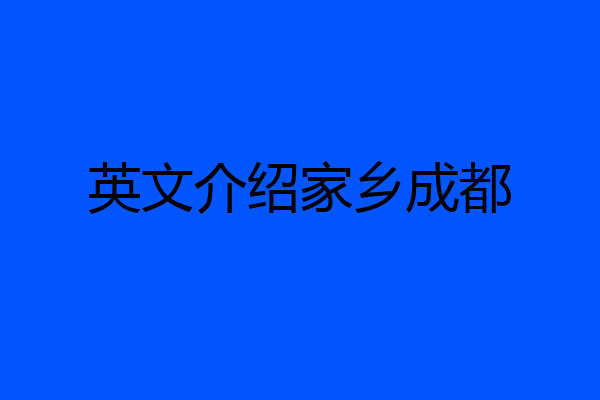
Sundy那抹阳光
Chengdu, the capital of Sichuan Province, lies in the hinterland of the Chengdu Plain, in central Sichuan.成都,四川省省会,是成都平原腹地,在四川中部. Covering a total land area of 12,400 square kilometers, Chengdu has a jurisdiction of over 7 districts, 4 cities and 8 counties.占地总面积为12400平方公里,成都有管辖权70区4城市和8个县. By the end of 1999, the population of Chengdu had reached 10.036 million, of which 3.30 million were urban residents.到1999年底,成都市人口已达1003.6万人,其中城镇居民330万人. Chengdu enjoys a long history.成都源远流长. 2,500 years ago, Kaiming IX, king of ancient Shu in the Zhou Dynasty (11th century 256BC), started to set up the capital in Chengdu.2500年前,开明九、古蜀国王在周代(11世纪华夏)着手成立了首都成都. "A town was built in this area in the first year and the capital in the second year, so the ancestor named the city as Chengdmeans to become a capital. Later on, Chengdu gradually became one of the most important centers of politics, ec onomy and culture in China. It has been the capital for the feudal dynasties five times and twice for the pe asant uprising regimes, known as Dashu and Daxi. As early as in the Han Dynasty (206BC-220AD)), Ch engdu began to enjoy the fame of one of the Top Five Capitals. In the Tang Dynasty (618-907), Ch engdu was reputed as the Yang (Yangzhou) first, yi (Chengdu) second; it had by then became the economic center just after Yangzhou. In the Western Han Dynasty (206BC-8AD), b rocades produced in Chengdu were very popular in China. So Chengdu was also called the City of Brocade. In the Fiv e Kingdoms Period (907-960), Mengchang, king of the Houshu Kingdom, dec reed to plant hibiscuses on the protective wall of the city, so Chengdu was also called the City of Hibiscus. As one of China's famous historical and cultural cities, Che ngdu enjoys rich tourist resources. 15,500 years ago, a well-known poet in the Jin Kingdom, Zuo Si extolled Chengdu as lofty and pretty. This city has also gained the eulogium by both Li Bai, the poet immortal and Du Fu, the poet sage. With rich cultural heritage and beautiful scenic spots, Chengd u is a peaceful and prosperous city."一城始建于这一领域,并在第一年资本在第二年所以轩辕命名为成都市城市,即成为首都.后来,成都逐渐成为世界上最重要的政治中心,欧洲共同体知识经济与中国文化.据首都封建王朝的5倍和两倍体育asant起义政权称为大暑、大溪.早在汉代(徘诙谐))的CH成都市开始享受富盛名的首都之一前五名.在唐代(六一八)、会堂成都市是这支被誉为扬(扬州)一,益(成都)二;资讯此时已成为仅次于扬州的经济中心.在西汉(徘8ad),二成都rocades制作非常流行.因此又被称为成都城织锦.在不确定性电子王国时期(借以抨击),何孟,蜀主王国的国王,12芦苇种植的防护墙hibiscuses市等成都又被称为芙蓉城.作为中国著名的历史文化名城,车林淑拥有丰富的旅游资源.15500年前,著名的诗人王国进、左成都泗赞颂高尚、漂亮.这个市还获得了李白的宇宙观,诗人杜甫、不朽的诗人圣者.拥有丰富的文化遗产和美丽的风景林金辉美国是一个和平与繁荣的城市.\As the capital city of Sichuan, Chengdu is a city with many faces. On the one hand this is an incredibly modern and vibrant place. Beijing has a relatively relaxed attitude towards this city and as such, Chengdu has blossomed in terms of affluence and investment.The traditional industries of gold, silver, silk and laquerware have helped to make this city one of the most important centers of commerce in the country. Today, skyscrapers dominate the skyline and Japanese cars and western goods are hugely popular and widely available.This modernization has no doubt been helped by the important role that Chengdu plays in terms of education and culture in China. Once one of the most important printing centers in the country, Chengdu has a long history as a destination for learned poets and artists to gather and seek inspiration. The great poet Du Fu, made his home here and today there are 14 colleges and an impressive university situated in the city.Nestled amongst this affluence and development is another side to Chengdu. Traditional wooden Chinese architecture that once dominated this city can still be found in the outskirts although it is fast disappearing. What does still exist here however in abundance, is a great street life. Markets and street hawkers fill the streets dealing in everything you could possibly imagine, from snakes and snails to fortunes and foot scrubs.Many travelers here are simply killing time or passing through en route to Tibet. This is however, a very pleasant city to do just this: feast on some great food and soak up some of the mellow atmosphere in one of the thousands of tea houses dotted about the city.


飘飘飞雪
Chengdu, the capital of Sichuan Province.
Chengdu, the capital of Sichuan Province, lies in the hinterland of the Chengdu Plain, in central Sichuan. Covering a total land area of 12,400 square kilometers, Chengdu has a jurisdiction of over 7 districts, 4 cities and 8 counties. A town was built in this area in the first year and the capital in the second year, so the ancestor named the city as Chengdu, which means to become a capital. Later on, Chengdu gradually became one of the most important centers of politics, economy and culture in China. It has been the capital for the feudal dynasties five times and twice for the peasant uprising regimes, known as Dashu and Daxi. As early as in the Han Dynasty (206BC-220AD)), Chengdu began to enjoy the fame of one of the Top Five Capitals. In the Tang Dynasty (618-907), Chengdu was reputed as the Yang (Yangzhou) first, yi (Chengdu) second; it had by then became the economic center just after Yangzhou. In the Western Han Dynasty (206BC-8AD), brocades produced in Chengdu were very popular in China. So Chengdu was also called the City of Brocade. In the Five Kingdoms Period (907-960), Mengchang, king of the Houshu Kingdom, decreed to plant hibiscuses on the protective wall of the city, so Chengdu was also called the City of Hibiscus. As one of China's famous historical and cultural cities, Chengdu enjoys rich tourist resources. 15,500 years ago, a well-known poet in the Jin Kingdom, Zuo Si extolled Chengdu as lofty and pretty. This city has also gained the eulogium by both Li Bai, the poet immortal and Du Fu, the poet sage. With rich cultural heritage and beautiful scenic spots, Chengdu is a peaceful and prosperous city.

吃货爱漫游
Chengdu is a prefecture level city under the jurisdiction of Sichuan Province. It is the capital, vice provincial city and mega city of Sichuan Province.
成都是四川省辖地级市,是四川省省会、副省级市、特大城市。
It is the core city of the two city economic circle in Chengdu Chongqing region, an important central city in Western China approved by the State Council, an important national high-tech industrial base, a business logistics center and a comprehensive transportation hub.
是成渝地区双城经济圈核心城市,国务院批复确定的中国西部地区重要的中心城市,国家重要的高新技术产业基地、商贸物流中心和综合交通枢纽。
名称由来
“成都”来历,据《太平寰宇记》记载,是借用西周建都的历史经过,取周王迁岐,一年而所居成聚,二年成邑,三年成都而得名蜀都。蜀语成都二字的读音就是蜀都。成者毕也、终也,成都的含义就是蜀国终了的都邑,或者说最后的都邑。
蜀汉、成汉、前蜀、后蜀等政权先后在此建都;一直是各朝代的州郡治所;汉为全国五大都会之一;唐为中国最发达工商业城市之一,史称“扬一益二”;北宋是汴京外第二大都会,发明世界上第一种纸币交子。拥有都江堰、武侯祠、杜甫草堂等名胜古迹,是中国最佳旅游城市。